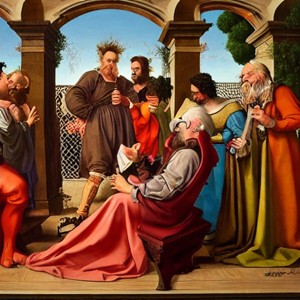Podcast: Play in new window | Download (19.5MB)

Thanks for joining me.
I am reluctantly considering the conclusion that much of what I have believed for as long as I have believed anything may represent far more hope than truth. Sure, I admit to taking it for granted that things actually are the way I have always thought they are, that my reality is valid and based on the true and factual, and that my sense of what’s real is correct and axiomatic. Naive? Simple-minded? Perhaps dangerous? Indeed. But nonetheless, I believed.
I take some comfort in knowing that a preference for belief over thoughtful consideration didn’t just start with me. The Roman philosopher Seneca observed that “Every man prefers belief to the exercise of judgment.” It’s likely that the “exercise” part of exercising judgment is the showstopper for many, if not most of us. For me at least, it has been easier to relax and believe.
Let me share a story that struggles with knowing truth from opinion, fact from belief. It gets at something important, I think.
1: A Discussion of Ideas
George had been retired for many years and was, by all accounts, set in his ways and beliefs. His daughters had asked him to discuss his views and outlook with them, hoping to gain a better understanding of him as a person and the experiences that had formed him. Youngsters, they argued, may not know what life was like when their father was in his prime, and they argued it was worthwhile for him to impart his wisdom.
The conversation began with George sharing his thoughts on a range of topics, from money management and world politics, to hard work and the purpose of life. He had very strong opinions and was keen for his daughters to take them on board and learn from them. However, the girls didn’t always agree and often challenged him, proposing their own ideas which didn’t always match up with his.
The discussion continued, with the subject matter becoming increasingly complex. However, one thing was becoming increasingly clear: George and his daughters were getting tangled up in trying to identify which elements of their respective beliefs and outlooks were true verses those which were not. They both seemed unable to distinguish fact from opinion and thus the conversation began to deadlock.
It was at this point someone made an interesting suggestion: why not agree to a way of telling true ideas from false ones? By finding a way to distinguish between belief and fact, hope was the conversation could begin to progress. Immediately, a spark of curiosity was kindled, as it dawned on all of them that this could be a fantastic experiment.
George and his daughters agreed to sit down at a later date to devise a way of identifying which ideas and notions were true and those which were not.
If I may interrupt,
Robert Brault got it right when he pointed out that “An old belief is like an old shoe. We so value its comfort that we fail to notice the hole in it.” To my surprise and disappointment, I am starting to notice cracks if not actual holes in some of my most trusted beliefs. The cause and solution may be as simple as E D Martin suggests, “It is easier to believe than to doubt.”
Laziness? Indifference? Bertrand Russell says it’s our inherent credulity. “Man is a credulous animal, and must believe something; in the absence of good grounds for belief, he will be satisfied with bad ones.” Perhaps I should add gullibility to lazy and naive. The picture is not looking good.
The pragmatist in me is calling out for attention. He or perhaps she is arguing that belief is not the issue. The issue is whether my unique collection of notions and ideas about how things are and how they work are serving me, furthering my interests. Admittedly, this is a rather pedestrian perspective; but if it works for me, I see little need to reason otherwise. If I may lean on Robert Brault again, “Sometimes you believe a thing that isn’t true because in the world you wish to live in, it would be true.” In the world I prefer, the way I arrange the pieces and parts, notions and ideas is reality, is worthy of belief.
Ok, I’ll get back to our story.

